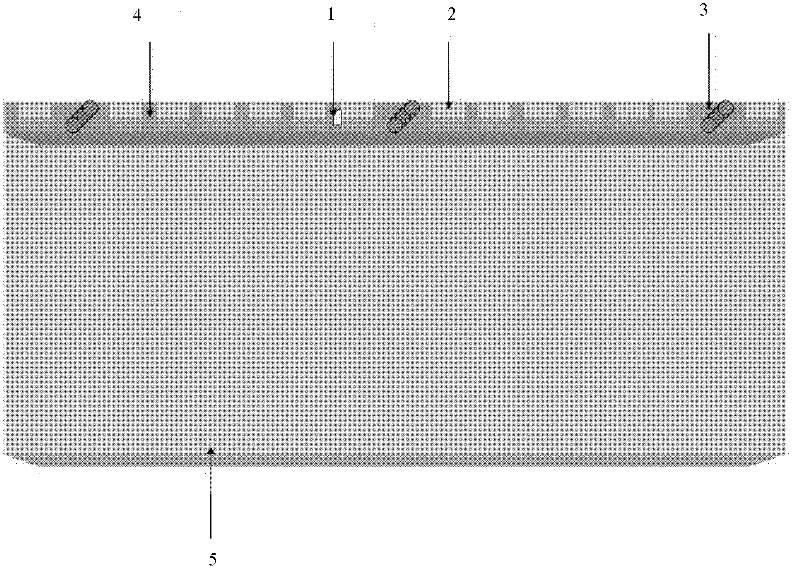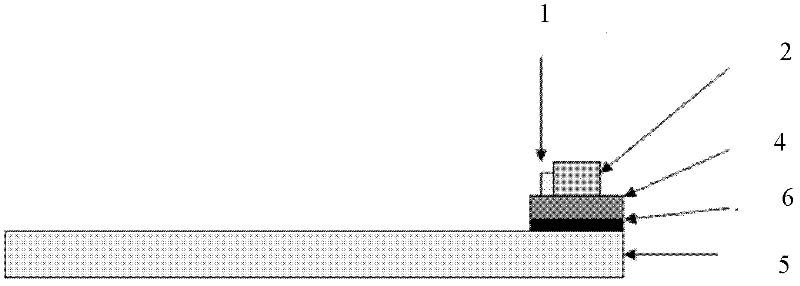Substrate-free pressure-sensitive acrylic thermal conductive adhesive, preparation method and application thereof
A technology of acrylic and heat-conducting adhesives, applied in the direction of adhesives, adhesive types, film/sheet-like adhesives, etc., can solve the problems of easy generation of thermal stress, deterioration of adhesive film performance, small diameter of heat-conducting particles, etc., and achieve high The effect of thermal conductivity
- Summary
- Abstract
- Description
- Claims
- Application Information
AI Technical Summary
Problems solved by technology
Method used
Image
Examples
Embodiment 1
[0066] The non-substrate pressure-sensitive acrylic thermally conductive adhesive of this embodiment is made according to the following steps:
[0067] 0.4g azobisisobutyronitrile and 40g ethyl acetate are formulated into initiator solution, and 4g carboxyl content is the multi-walled carbon nanotube (diameter 100nm, length 500nm) of 1.1% and 16g carbon fiber (carboxyl content is 0.05%) Pitch-based carbon fiber, diameter 5000nm, length 6000nm), 3g acrylic acid, 80g n-butyl acrylate, 20g 2-ethylhexyl acrylate and 140g ethyl acetate are formulated into a monomer solution, 3.5g magnesium acetate and 80g ethyl acetate Prepared as curing agent solution;
[0068] In the reactor with material mixing function and temperature control function, the temperature of the monomer solution is raised to 76 ° C, and the initiator solution is added dropwise to the monomer solution for 5 times to carry out the polymerization reaction, and the time of each drop is 10 minutes. After the addition, ...
Embodiment 2
[0073] The non-substrate pressure-sensitive acrylic thermally conductive adhesive of this embodiment is made according to the following steps:
[0074] 0.35g azobisisobutyronitrile and 30g ethyl acetate are formulated into initiator solution, and 2g carboxyl content is the multi-walled carbon nanotube (diameter 80nm, length 1000nm) of 1.5% and 15g carbon fiber (carboxyl content is 0.09% carboxyl The pitch-based carbon fibers that have been melted have a diameter of 6000nm and a length of 7000nm), 4.5g acrylic acid, 50g isobutyl acrylate, 10g lauryl acrylate, 15g 2-ethylhexyl acrylate, and 100g ethyl acetate to prepare a monomer solution. 3g magnesium acetate and 50g ethyl acetate are mixed with curing agent solution;
[0075] In the reactor with material mixing function and temperature control function, the temperature of the monomer solution is raised to 76 ° C, and the initiator solution is added dropwise to the monomer solution for polymerization reaction in 6 times, and th...
Embodiment 3
[0079] The non-substrate pressure-sensitive acrylic thermally conductive adhesive of this embodiment is made according to the following steps:
[0080] 0.5g azobisisobutyronitrile and 45g ethyl acetate are mixed with initiator solution, and 2.5g carboxyl content is the multi-walled carbon nanotube (diameter 30nm, length 500nm) of 2.3% and 17.5g carbon fiber (carboxyl content is 0.05 % carboxylated pitch-based carbon fiber, diameter 5000nm, length 8000nm), 4g acrylic acid, 1g methacrylic acid, 55g n-butyl acrylate, 28g acrylate-2-ethylhexyl, 165g ethyl acetate are mixed with monomer solution, will 2.5g magnesium acetate tetrahydrate and 50g ethyl acetate are mixed with curing agent solution;
[0081] In the reactor with material mixing function and temperature control function, the temperature of the monomer solution is raised to 76 ° C, and the initiator solution is added dropwise to the monomer solution for 5 times to carry out the polymerization reaction. The time for each d...
PUM
| Property | Measurement | Unit |
|---|---|---|
| diameter | aaaaa | aaaaa |
| length | aaaaa | aaaaa |
| diameter | aaaaa | aaaaa |
Abstract
Description
Claims
Application Information
 Login to View More
Login to View More - R&D
- Intellectual Property
- Life Sciences
- Materials
- Tech Scout
- Unparalleled Data Quality
- Higher Quality Content
- 60% Fewer Hallucinations
Browse by: Latest US Patents, China's latest patents, Technical Efficacy Thesaurus, Application Domain, Technology Topic, Popular Technical Reports.
© 2025 PatSnap. All rights reserved.Legal|Privacy policy|Modern Slavery Act Transparency Statement|Sitemap|About US| Contact US: help@patsnap.com



